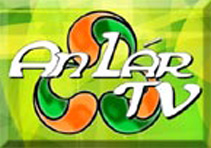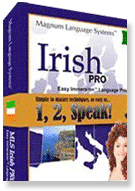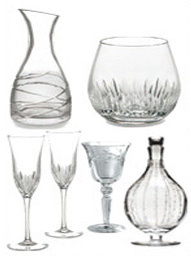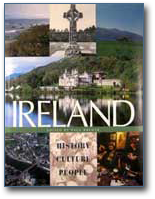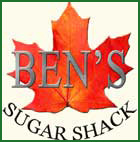Native Irish Dog Breeds
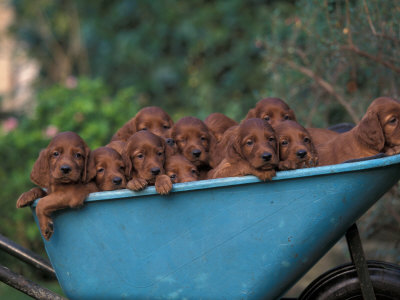 |
A Wheelbarrow Full of Irish / Red Setter Puppies
Photographic Print Buy at AllPosters.com |
Irish Terrier
An Irish Terrier Giclee Print
Buy at AllPosters.com
Ireland has produced four terrier breeds, all of which are markedly different from terriers on the continent and in England. The dog now officially called Irish Terrier is possibly the oldest of the Irish terrier breeds, however, it would be difficult to prove this conclusively. Before the 1880's, the color of the Irish Terrier had not been settled, sometimes with red, sometimes black and tan, and sometimes brindle. At the end of the 19th century, efforts were made to breed out the black and tan and the brindles. By the 20th century all Irish Terriers showed the red coat, and it soon made its appearance at dog shows in England and in the United States, where it was enthusiastically received. During World War I, they were used as messenger dogs in the noise and confusion of trench warfare, which proved their intelligence and fearlessness. The first breed club was set up in Dublin in 1879 and the Irish Terrier was the first member of the terrier group to be recognized by the English Kennel Club as a native Irish breed.
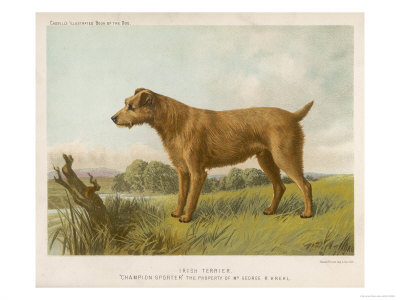 |
Irish Glen of Imaal
Head Portrait of
Irish Glen of Imaal Terrier Dog Photographic Print
Buy at AllPosters.com
Many dogs in the terrier group were not really appreciated by gentlemen sportsmen before the 1850's. The Irish Glen of Imaal is an old breed that was ignored for a long time before results of later breeding experiments brought attention to him. He is a local dog, confined to the bleak area of the Glen of Imaal. The farmers of this area used their natural cunning and dexterity to survive in the harsh terrain. The Irish Glen had evolved through generations of hard work into the strong sturdy dog we know today. The Irish Kennel Club officially recognized the breed in 1934 and a club to promote its interest was formed.
 |
Irish Soft Coated Wheaten Terrier
The Irish Soft Coated Wheaten Terrier is probably the oldest of the four breeds. It's existence is noted from 200 year old text references to "soft-coated" dogs. The relationship of the modern Irish Terrier to the Wheaten appears to be the result of deliberate breeding experiments, probably resulting in a fairly mixed ancestry. Despite the long history of the Soft Coated Wheaten Terrier, it was not officially recognized by the Irish Kennel Club until 1937. The popularity of the breed has grown steadily and is now internationally known.
Kerry Blue
Like the other Irish Terrier breeds, the Kerry Blue has been in the country for centuries. Because of its humble origins as a rat catcher and farm dog, there are few references to the breed before the 20th century. The first literary references to the Kerry Blue dates from 1847, in which the author describes 'a bluish slate-colored dog, marked with darker blotches and patches, and often with tan about the legs and muzzle'. This blackish-blue Irish terrier was prevalent in Kerry but it has been developed in other counties as well. The blue made its first appearance on the show circuit in 1913, and the Dublin Blue Terrier Club was formed in 1920. The Kerry Blue quickly became popular as a sort of mascot for Irish patriots. With its reputation as an excellent working and companion dog, it was considered to be nearly perfect.
Kerry Beagle
The Kerry Beagle is one of the most ancient breeds of Irish dog. Next to the Irish Wolfhound, the Kerry Beagle may actually be the oldest native Irish breed. It is thought that the dog referred to as 'GADHAR' in old Irish texts may be the direct ancestor of the modern day Kerry hound. The most likely outline of the history of this breed is a Celtic hound going back to the time of the first Celtic settlements in Ireland. In the middle ages and later centuries, the breed was mixed through experiments with hounds from the continent to produce an efficient hunting dog. They unfortunately suffered during the great hunger in Ireland in 1847 and were decimated by starvation. The name 'beagle' is derived from the Irish word 'beag' (meaning small) and the Beagle is a small hound used to hunt small game. Larger hounds like the Kerry Beagle were often used to hunt stag. The present day word for the Beagle in Irish is 'Pocadan' which refers to its use as a hunting dog rather than by it's size
Water Spaniels
An Irish Water Spaniel in the Field Giclee Print
Buy at AllPosters.com
The exact origins of this breed remain obscure. It is thought that Water Spaniels evolved from dogs that originated in Persia and came to Ireland via Spain. The first Irish reference to 'water dogs that pursue water fowl' dates from 1600. There is no real evidence of the ancestry of the Irish Water Spaniel except in its most peculiar feature, the rat tail. This feature appears in no similar dog and makes it very likely that the modern breed had an indigenous Irish ancestor. The descendants of these dogs were accepted and achieved great success at shows in the second half of the 19th century. The Irish Water Spaniel Club was formed in 1890.
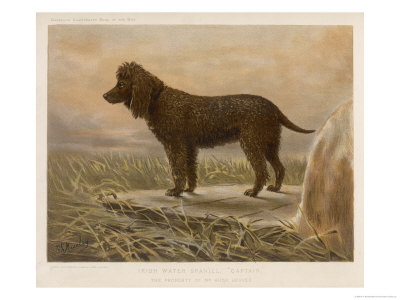 |
Irish Wolfhounds
The Irish Celts were interested in breeding large hounds, and these large Irish hounds could have had smooth or rough coats. In later times, the rough coat became predominate possibly due to the Irish climate. The first written account of these dogs was in a Roman document from 391 A.D. but they were already established in Ireland in the Uisneach (first century) A.D. Sétanta changed his name to Cu-Chulainn (the Hound of Culann). Irish hounds probably formed the basis of the Scottish Deerhound. Pairs of Irish hounds were prized as gifts by the royal houses on the European continent from the Middle Ages to the 17th century. In the 15th century, each county in Ireland was required to keep twenty-four wolfhounds to protect the flocks of sheep from the wolves. The gradual disappearance of the wolf, and continued demand abroad, reduced their numbers almost to the point of extinction by the end of the 17th century. In the late 19th century, there was renewed interest in the breed and the Irish Wolfhound became a living symbol of Irish culture and of the Celtic past. At this time, Capt. G. A. Graham obtained a few of the remaining wolfhounds in Ireland, and he eventually achieved a type of dog that bred true in every generation. The results were ultimately accepted as a legitimate revival of the breed. The Irish Kennel Club recognized a class for Irish Wolfhounds at their show in 1879 and a club was formed in 1885.
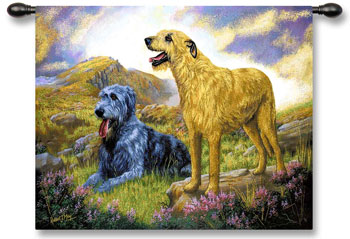 |
Red and White Irish Setter
The Irish Setter came into its own at the end of the 17th century. A fact not well known outside of Ireland is that there are two breeds of Irish Setters, however, it is certain that the Red and White Setter is the older of the two. Selective breeding evolved into the solid red color, which resulted in much confusion about their proper color. By the end of the 19th century, the Red Setter had become more predominate than the Red and White. The Red & White Setters became so rare that they were thought to be extinct. In the 1920's, efforts were made to revive the breed and, by 1944, it had re-established itself well enough to have a club of its own. The Irish Red & White Setter Field & Show Society was formed in 1981 and, through its endeavors and direction, the breed is now well established internationally.
Red Irish Setter
The Irish Red Setter was developed in Ireland as a working dog for hunting. The breed is derived from the Irish Red and White Setter and an unknown solid red colored dog. It was a clearly identified as its own breed in the 18th century. The Irish Red Setter Club was established in 1882 and the breed has evolved down through the years into a hardy, healthy, intelligent dog, possessed of excellent working ability and great stamina.
For more detailed information and specifications of these native Irish dog breeds, have a look at the web site of the Irish Kennel Club.
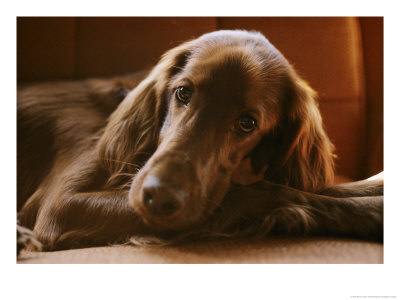 |
Disclaimer: LittleShamrocks.com is an affiliate website that receives commissions from sales of the products listed. We have purchased and sampled many, but not all, of the products on these pages.
© Copyright LittleShamrocks.com. All Rights Reserved.



